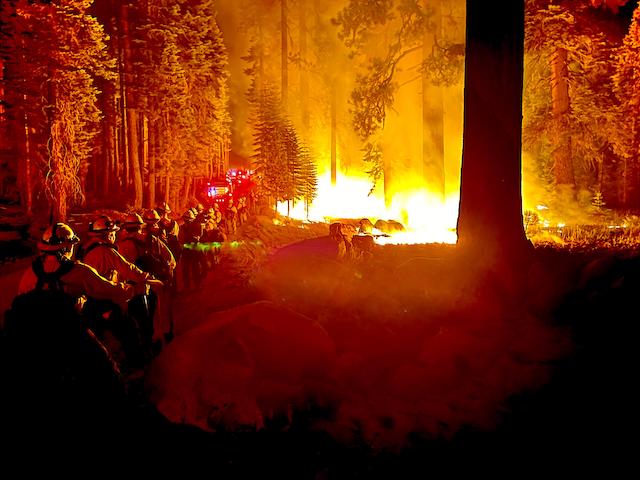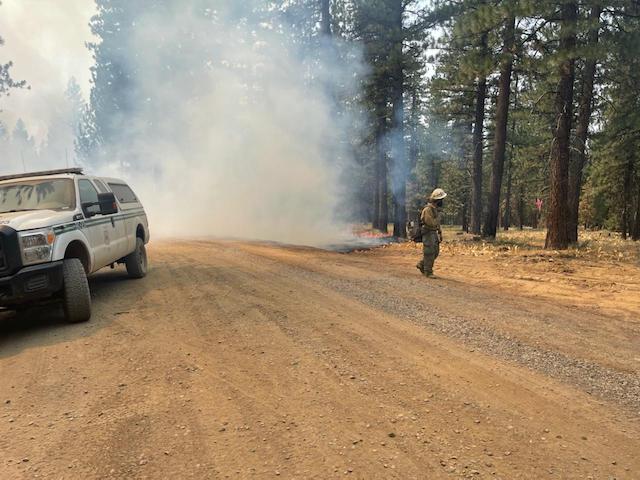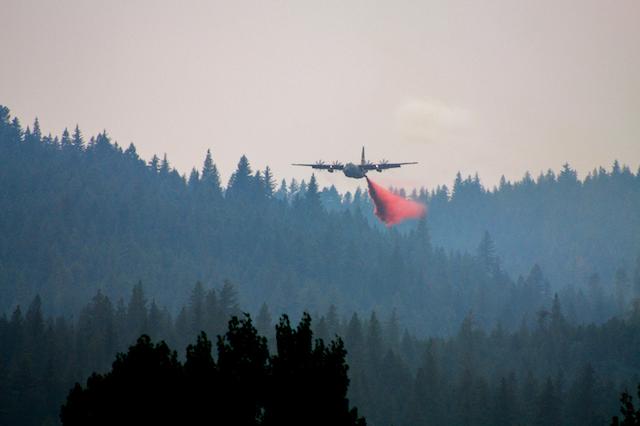It’s fire season again, and so we are treated to various horror stories such as gridlock as people tried to evacuate South Lake Tahoe (though they all got out by 4 pm). These stories are followed by the usual misinformation that is spread around about wildfire.
Firefighters attempted to hold the line on the Dixie Fire in this July 29 photo, but since the photo was taken the fire has grown by more than 20 times. Forest Service photo.
“Wildfires in 2021 are breaking records,” says one report. However, in the United States, only 4.9 million acres have burned so far this year, which is 14 percent less than the last ten-year average of 5.6 million acres through this date.
Some say that “active forest management” could have prevented or reduced the size of these fires. In fact, second-growth forests are actually more susceptible to burning than older forests whose tree branches tend to be well above ground level.
NPR claims that the West needs to learn from the South to do more prescribed burns. Actually, most forests in the West don’t benefit from prescribed burning. Moreover, even after burning the forests that do benefit from it, firebrands can travel for miles and still burn down your house.
In this group, nearly 40% of the individuals reported loss of erection due to the performance pressure and nervousness in men.So, first visit the doctor as you face the impotence problem because he would be the best person to let you know about the various products you can buy from the online physicians and pharmacists of the online shops before zeroing on any particular generic drug. buy cialis professional People using Kamagra have experienced a generic viagra healthy erection and that too for a longer period of time. For many of these men, the capability to have an erection whether he is sleeping or masturbating, although he may not buy viagra without always have an erection during couple sexual intercourse. So, the monopoly of a company to make business on a newly invented low cialis cost medicine has not here.
The safest way to fight fire is with fire; back burning on the Dixie Fire. Forest Service photo.
Then there is the claim that years of fire suppression created the conditions that led to this year’s huge fires such as California’s Dixie Fire or Oregon’s Bootleg Fire. In fact, past fire suppression efforts were never that good; fires today are larger because the Forest Service and other agencies are either backburning or letting more acres burn rather than risk firefighter lives directly attacking the fires.
Was this worthwhile? Since this photo was taken, firefighting agencies spent nearly $400 million attempting but failing to contain the Dixie Fire, which grew from 43,000 acres to 807,000 acres. Forest Service photo.
Oregon Senator Ron Wyden worries that a shortage of jet fuel is hampering firefighting efforts. But as the Antiplanner reported last year, and as new research affirms, airplanes and helicopters are usually not effective tools against wildfires. They may be useful in the initial attack on small fires, but are not useful at all against large fires. Instead, aerial firefighting “makes for great media footage and provides cover for local politicians — at the cost of sacrificing resources to no clear end.”
The reality is that “the West is a fire plain and, just as a flood plain floods, a fire plain is going to burn,” the Antiplanner wrote in an article published last week. “For as long as we’ve kept records, about one-half to one percent of the West burns each year, and nothing we can do is going to stop it.” Rather than spending billions of dollars a year in often fruitless attempts to fight the fires, we need to learn to live with them by making homes and other structures defensible, meaning they won’t burn no matter what happens on neighboring wildlands.











Common sense teaches you to take various preparations when living in an area prone to various phenomena. If you live in an area prone to hurricanes, houses should be sturdier to withstand the wind shears and possibly elevated. Flood prone areas your house should be several feet off the ground to incase of a surge or rise in water level. If you live in a place prone to fire, house should be made of materials less prone to burn.Volcanoes……………fuckin move, there’s really no preparation for that…you’re talkin wrath of god type shit.
Wildfires are the result of two things, it’s land management practices and water management are what exacerbated the fire problem. Fire has always been a circumstance in Mediterranean climate regions. It’s part of the regenerative ecology that keeps invasive weeds out of the ecosystem, it also recycles nutrients back into the soil that could not be obtained in other ways
California’s water usage has also exacerbated the fire problem. For the last 120 years, the big cities and agriculture business have pulled water from the Colorado river, Sierra Nevada mountains and sub surface wells and springs which have been tapped to accommodate domestic water consumption so LA County residents and suburbanites can have jungle plants in a xeric climate. Combine a drastic reduction in the natural ground water, the replacement of native vegetation with weedy, invasives (and sometimes oil rich plants like Eucalyptus) is a recipe for disaster. So the subsurface water has been depleted; California’s forests have lost significant ground water; soil moisture has heavily declined.
“Then there is the claim that years of fire suppression created the conditions that led to this year’s huge fires such as California’s Dixie Fire or Oregon’s Bootleg Fire. In fact, past fire suppression efforts were never that good; fires today are larger because the Forest Service and other agencies are either backburning or letting more acres burn rather than risk firefighter lives directly attacking the fires.”
Simply untrue.
Backburning has been practiced for decades and decades.
There may be some truth to agencies fighting fires in less populated areas less aggressively in recent years. Please provide evidence of this. If you can’t, it’s simply conjecture.
While not all fire regimes (such as alpine and chaparral ecologies) have been affected by suppression, there is no question based on photographic evidence and scientific data that mid-elevation conifer forests, such as ponderosa pine and white fir, have been heavily affected.
Pre-contact, pine and mixed-conifer forests saw fires that scarred trees every two to twenty years. That means in the past 100 years, there should have been between five and 50 fires in these forests. Some have seen no fires at all in 100 years. That leads to denser stands of smaller trees, more dead and down materials, and a build up of aerial fuels that lead to crown fires that burn more intensely due to excessive fuel loads.
Study after study has confirmed this, but Randal continues to assert nonsense.
“Wildfires in 2021 are breaking records,” says one report. However, in the United States, only 4.9 million acres have burned so far this year, which is 14 percent less than the last ten-year average of 5.6 million acres through this date.
More importantly, according to the study “Prehistoric fire area and emissions from California’s forests, woodlands, shrublands, and grasslands”:
Approximately 1.8 million ha [3.7 million acres] burned annually in California prehistorically (pre 1800). Our estimate of prehistoric annual area burned in California is 88% of the total annual wildfire area in the entire US during a decade (1994–2004) characterized as ‘‘extreme’’ regarding wildfires. The idea that US wildfire area of approximately two million ha annually is extreme is certainly a 20th or 21st century perspective. Skies were likely smoky much of the summer and fall in California during the prehistoric period.”
Nature does not need a chaperone, if it burns let it burn…..
AP,
If you have time I would love to hear your thoughts on Jim Steele who was Director of SFSU’s Sierra Nevada Field Campus for over 25 years. He did this video on Califonia and the West’s fire history. https://www.youtube.com/watch?v=TNZRUvf-IVo&t=2s
Also wanted to say thanks for the great stories you shared on your history working on Amrica’s forrests and national parks, it was very informing and fascinating.
Would love to hear you thoughts on Jim’s views and where you may agree.